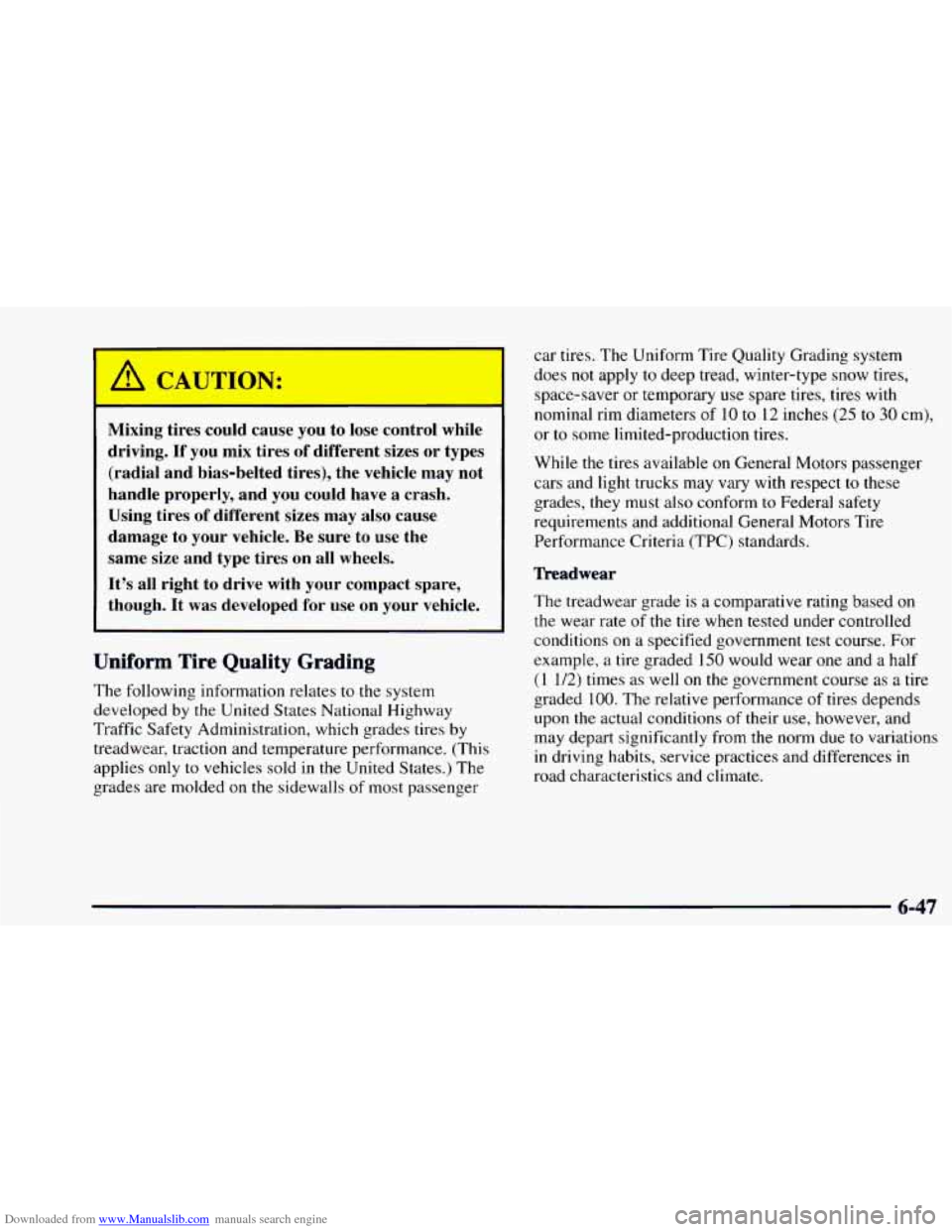Page 252 of 404
Downloaded from www.Manualslib.com manuals search engine 3. Put the flat end of the extension on an angle through
the hole in the rear door frame, above the bumper.
Turn the ratchet clockwise until the tire is against the
underside
of the vehicle.
You will feel two “clicks” when the tire is up all the
way. Try
to move the tire with your hands to make
sure it is securely in place.
The compact spare is for temporary use
only. Replace
the compact spare tire with a full-size tire as soon as you
can. See “Compact Spare Tire”
in the Index. See the
storage instructions label to restore your compact
spare properly.
Return the jacking equipment
to its proper location.
I
3
. Jacking Tool Storage Bag
2. Jack
3. Bracket
4. Jacking Instruction Tag
5. Bolt/Screw
6. Wheel Blocks
7. Washer
8. Nut
5-34
Page 253 of 404

Downloaded from www.Manualslib.com manuals search engine Compact Spare Tire
Although the compact spare tire was fully inflated when
your vehicle was new, it can lose air after a time. Check
the inflation pressure regularly. It should be
60 psi
(420 kPa).
After installing the compact spare
on your vehicle, you
should stop as soon as possible and make sure your
spare tire is correctly inflated. The compact spare is
made
to perform well at speeds up to 65 mph
(105 kdh) for distances up to 3,000 miles (5 000 km),
so you can finish your trip and have your full-size tire
repaired
or replaced where you want. Of course, it’s best
to replace your spare with a full-size tire as soon as
you
can. Your spare will last longer and be in good shape in
case
you need it again.
NOTICE:
When the compact spare is installed, don’t take
your vehicle through an automatic car wash with
guide rails. The compact spare can get caught on
the rails. That can damage the tire and wheel,
and maybe other parts
of your vehicle.
Don’t use your compact spare on other vehicles.
And don’t mix your compact spare tire or wheel with
other wheels or tires. They won’t
fit. Keep your spare
tire and its wheel together.
NOTICE:
Tire chains won’t fit your compact spare. Using
them can damage your vehicle and can damage
the chains too. Don’t use tire chains on your
compact spare.
5-35
Page 303 of 404

Downloaded from www.Manualslib.com manuals search engine 1 /r CAUTION:
Mixing tires could cause you to lose control while
driving. If you mix tires of different sizes or types
(radial and bias-belted tires), the vehicle
may not
handle properly, and you could have
a crash.
Using tires of different sizes may also cause
damage to your vehicle. Be sure to use the
same size and type tires on
all wheels.
It’s all right to drive with your compact spare, though.
It was developed for use on your vehicle.
Uniform Tire Quality Grading
The following information relates to the system
developed
by the United States National Highway
Traffic Safety Administration, which grades tires by
treadwear, traction and temperature performance. (This
applies only to vehicles sold in
the United States.) The
grades are molded
on the sidewalls of most passenger car
tires. The Uniform Tire Quality Grading system
does
not apply to deep tread, winter-type snow tires,
space-saver
or temporary use spare tires, tires with
nominal rim diameters
of 10 to 12 inches (25 to 30 cm),
or to some limited-production tires.
While the tires available
on General Motors passenger
cars and light trucks may vary with respect to these
grades, they must also conform to Federal safety
requirements and additional General Motors Tire
Performance Criteria (TPC) standards.
Treadwear
The treadwear grade is a comparative rating based on
the wear rate of the tire when tested under controlled
conditions
on a specified government test course. For
example, a tire graded 150 would wear one and a half
(1 1/2) times as well on the government course as a tire
graded
100. The relative performance of tires depends
upon the actual conditions of their use, however, and
may depart significantly from the norm due to variations
in driving habits, service practices and differences in
road characteristics and climate.
6-47
Page 306 of 404

Downloaded from www.Manualslib.com manuals search engine Tire Chains Appearance Care
Remember, cleaning products can be hazardous. Some
are toxic. Others can burst
into flame if you strike a
match or get them on
a hot part of the vehicle. Some are
dangerous
if you breathe their fumes in a closed space.
When you use anything from
a container to clean your
vehicle, be sure to follow the manufacturer’s warnings
and instructions. And always open your doors
or
windows when you’re cleaning the inside.
Never use these to clean your vehicle:
NOTICE:
If your vehicle has P235/65R15 size tires, don’t
use tire chains. They can damage your vehicle
because there’s not enough clearance.
If you have other size tires, use tire chains only
where legal and only when you must. Use only
SAE Class “S” type chains that are the proper
size for your tires. Install them on the rear axle
tires and tighten them as tightly
as possible with
the ends securely fastened. Drive
slowly and
follow the chain manufacturer’s instructions. If
you can hear the chains contacting your vehicle,
stop and retighten them.
If the contact continues,
slow down until it stops. Driving
too fast or
spinning the wheels with chains on will damage
your vehicle.
0 Gasoline
Benzene
Naphtha
0 Carbon Tetrachloride
0 Acetone
a Paint Thinner
Turpentine
0 Lacquer Thinner
0 Nail Polish Remover
They can
all be hazardous -- some more than
others
-- and they can all damage your vehicle, too.